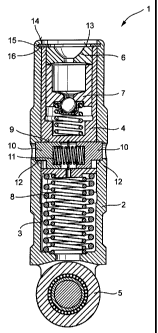Some of the information on this Web page has been provided by external sources. The Government of Canada is not responsible for the accuracy, reliability or currency of the information supplied by external sources. Users wishing to rely upon this information should consult directly with the source of the information. Content provided by external sources is not subject to official languages, privacy and accessibility requirements.
Any discrepancies in the text and image of the Claims and Abstract are due to differing posting times. Text of the Claims and Abstract are posted:
| (12) Patent: | (11) CA 2404072 |
|---|---|
| (54) English Title: | SWITCHING ELEMENT FOR A VALVE TRAIN OF AN INTERNAL COMBUSTION ENGINE |
| (54) French Title: | COMMUTATEUR DE COMMANDE DES CULBUTEURS ET POUSSOIRS DE SOUPAPES DE MOTEUR A COMBUSTION INTERNE |
| Status: | Deemed expired |
| (51) International Patent Classification (IPC): |
|
|---|---|
| (72) Inventors : |
|
| (73) Owners : |
|
| (71) Applicants : |
|
| (74) Agent: | MACRAE & CO. |
| (74) Associate agent: | |
| (45) Issued: | 2009-12-29 |
| (22) Filed Date: | 2002-09-18 |
| (41) Open to Public Inspection: | 2003-03-19 |
| Examination requested: | 2007-08-15 |
| Availability of licence: | N/A |
| (25) Language of filing: | English |
| Patent Cooperation Treaty (PCT): | No |
|---|
| (30) Application Priority Data: | ||||||
|---|---|---|---|---|---|---|
|
The invention proposes a switching element (1) for a valve train of an internal combustion engine, said switching element comprising an outer element (2) and an inner element (4) that is arranged for axial displacement in a bore (3) of the outer element (2), each of the outer element (2) and the inner element (4) comprising at least one reception (12, 9) aligned to each other in an axially distant relative position which is achieved through a lost motion spring (8), at least one piston (10) being arranged in at least one of the receptions (12, 9) for sliding toward the other of the receptions (12, 9) to couple the inner element (4) to the outer element (2) in said relative position, and a high-position stop for defining said relative position being arranged between the inner element (4) and the outer element (2). The inventive high-position stop is made as a separate element (16) such as a disk or a circlip with a variable thickness that is fixed on one of the outer element (2) and the inner element (4) and cooperates with a stop surface of the other of the outer element (2) and the inner element (4). These extremely simple fabrication measures enable an alignment of the receptions (9, 12) for achieving coupling.
L'invention propose un commutateur (1) de commande des culbuteurs et poussoirs de soupapes de moteur à combustion interne, ledit commutateur comprenant un élément externe (2) et un élément interne (4) qui est conçu pour un déplacement axial dans un alésage (3) de l'élément externe (2), chacun de l'élément externe (2) et de l'élément interne (4) comprenant au moins une réception (12, 9) alignée l'une par rapport à l'autre dans une position relative axialement éloignée qui est obtenue par un ressort à perte de mouvement (8), au moins un piston (10) étant disposé dans au moins une des réceptions (12, 9) pour glisser vers l'autre réception (12, 9) afin de coupler l'élément interne (4) à l'élément externe (2) dans cette position relative, et une butée en position élevée pour définir ladite position relative étant disposée entre l'élément interne (4) et l'élément externe (2). La butée en posiiton élevée de l'invention est constituée comme un élément séparé (16) tel qu'un disque ou un circlipcirclip ayant une épaisseur variable qui est fixe sur l'un ou l'autre de l'élément externe (2) et de l'élément interne (4) et coopère avec une surface de butée de l'autre élément parmi l'élément externe (2) et l'élément interne (4). Ces mesures de fabrication extrêmement simples permettent un alignement des réceptions (9, 12) pour obtenir un couplage.
Note: Claims are shown in the official language in which they were submitted.
Note: Descriptions are shown in the official language in which they were submitted.

For a clearer understanding of the status of the application/patent presented on this page, the site Disclaimer , as well as the definitions for Patent , Administrative Status , Maintenance Fee and Payment History should be consulted.
| Title | Date |
|---|---|
| Forecasted Issue Date | 2009-12-29 |
| (22) Filed | 2002-09-18 |
| (41) Open to Public Inspection | 2003-03-19 |
| Examination Requested | 2007-08-15 |
| (45) Issued | 2009-12-29 |
| Deemed Expired | 2014-09-18 |
There is no abandonment history.
Note: Records showing the ownership history in alphabetical order.
| Current Owners on Record |
|---|
| SCHAEFFLER TECHNOLOGIES AG & CO. KG |
| Past Owners on Record |
|---|
| INA-SCHAEFFLER KG |
| SCHAEFFLER KG |
| SCHAEFFLER TECHNOLOGIES GMBH & CO. KG |
| SCHNELL, OLIVER |